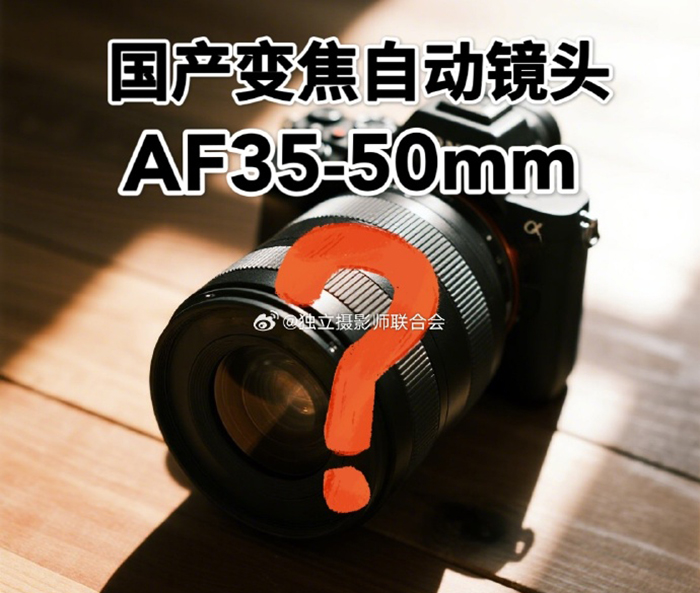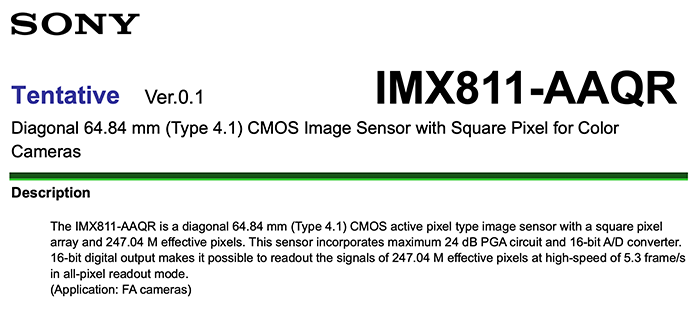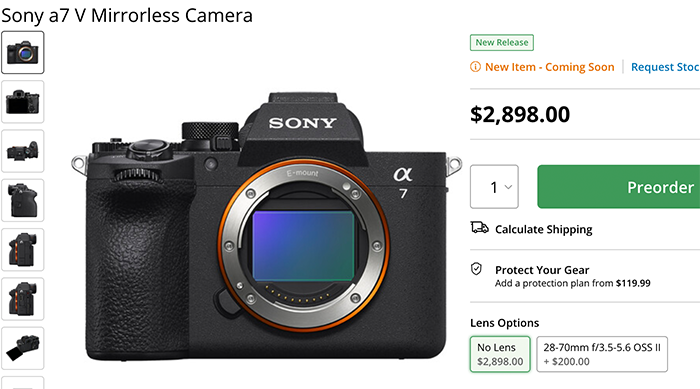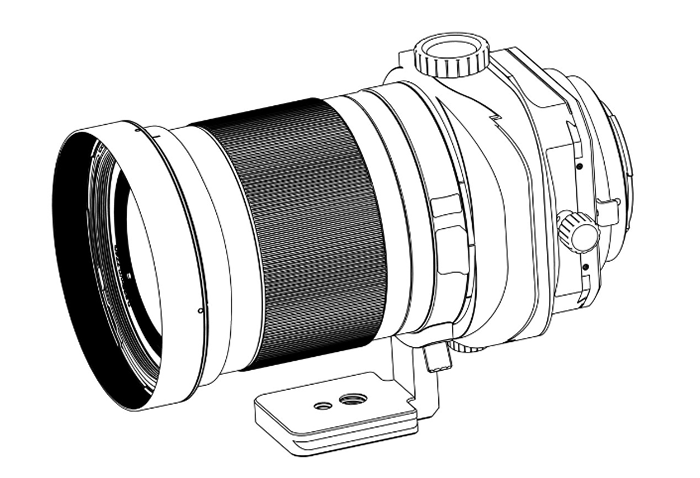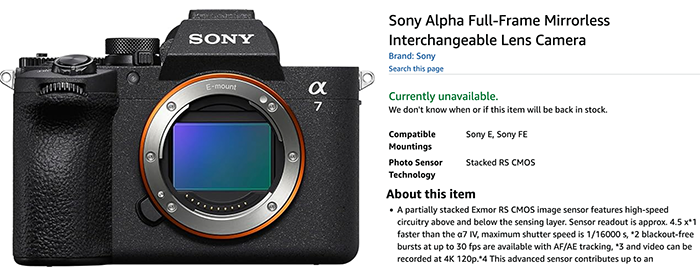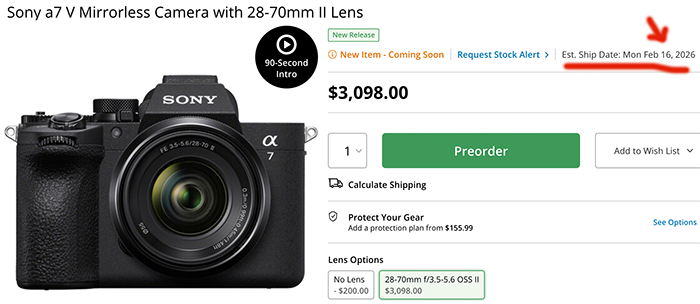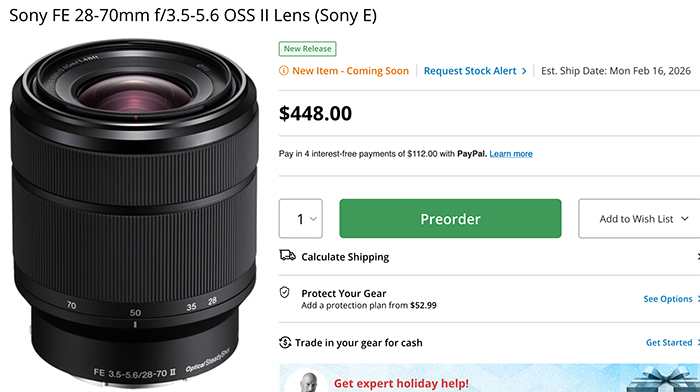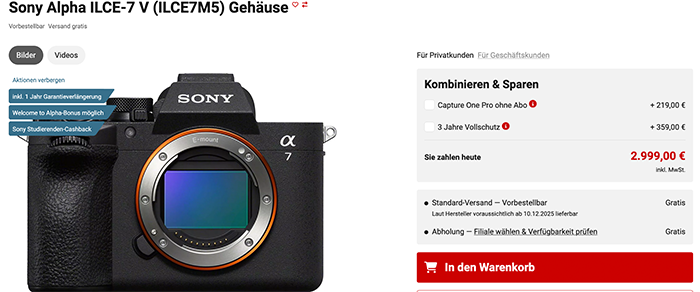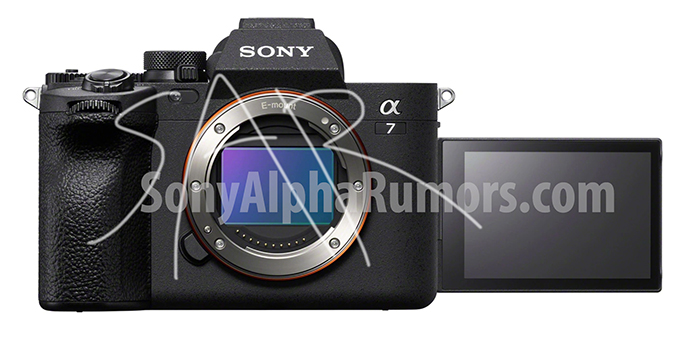
Sony A7V at BHphoto, Amazon, Adorama, Fotokoch, Foto Erhardt, Calumet, WexUK, Clifton, Park UK, Henrys, Camera Pro, Sony Australia.
This is the google translated press text:
The Sony Alpha 7 V full-frame mirrorless camera combines professional-grade speed and performance in a compact body, designed to meet any creative challenge.
With its AI-powered autofocus, 33 megapixels with 16 stops of dynamic range, 7.5 stops of image stabilization, 30 fps continuous shooting with RAW+JPG pre-capture, and video recording up to 4K 120p, the Alpha 7 V offers a unique combination for mirrorless creators seeking precision, freedom, and exceptional images. From fast-moving subjects and intimate portraits to cinematic scenes, the Alpha 7 V captures images true to your vision, delivering an experience that exceeds expectations and empowers every creator to reach their full potential.
CAPTURE EVERY MOMENT
Shoot at up to 30 fps in continuous bursts without viewfinder break and with the pre-capture function that saves images up to 1 second before the shutter release. Track fast-moving subjects without ever losing sight of them thanks to the semi-stacked sensor. The Alpha 7 V is ideal for wildlife, sports, and action photography enthusiasts who want to capture every important moment with absolute precision.
REALISTIC IMAGE QUALITY
Achieve exceptional image quality in both stills and video, thanks to the new 33-megapixel semi-stacked Exmor RS CMOS sensor offering up to 16 stops of dynamic range, ideal color rendition, and extremely low ISO noise. Combined with the 2nd generation BIONZ XR2 processor, the Alpha 7 V brings every scene to life, from breathtaking landscapes during the golden hour to colorful city nights, with remarkable depth and clarity.
SMARTER FOCUS FOR EVERY SUBJECT
Powered by the 2nd generation BIONZ XR2 processor, the Alpha 7 V uses advanced AI to recognize and track all subjects: humans, animals, birds, insects, cars, and more, with full-body modeling and precise eye detection for both humans and animals. Real-time autofocus locks sharpness onto subjects in both photos and videos, even when they’re moving quickly and unpredictably, so every image stays perfectly sharp and your creativity never stops.
CINEMATIC VIDEO WITHIN REACH
Record 4K 120p (Super 35) or 4K 60p (full-frame) video in 10-bit 4:2:2 for smooth slow motion and professional color grading. Support for S-Cinetone™, S-Log3 cine3, and LUT preview makes it easy to achieve cinematic looks directly from the camera and simplifies post-production.
RELIABLE WITH EVERY SHOT
Enjoy unprecedented mobility with up to 7.5 stops of in-camera image stabilization that keeps every shot steady, even when shooting handheld in low light. The enhanced grip and four-axis tilting 3.2-inch LCD screen allow for smooth, comfortable, flexible, and easy shooting from any angle, so you can focus entirely on capturing the moment.
BUILT FOR REAL-LIFE CONDITIONS
Designed for demanding shooting situations, the Alpha 7 V combines efficient heat dissipation with extended battery life for longer, uninterrupted shooting sessions. Transfer your images and videos faster via the Creators’ App, wired or wirelessly (WiFi 6), for effortless sharing and remote control. With its rugged, all-weather body, the Alpha 7 V goes wherever your creativity takes you.
| Dimensions |
130.3 × 96.4 × 82.4 mm |
| Country of Manufacture |
Manufactured outside Europe |
| Package Type |
Body only |
| Photography Level |
Professional |
| Wireless Communication |
Bluetooth 5.3, Wi-Fi 6 dual MIMO 2.4/5/6 GHz |
| Direct Printing |
No |
| Memory Card Format |
Secure Digital, CFexpress Type A |
| FNAC-DARTY Pack |
No |
| Color |
Black |
| Zoom Characteristics |
Approx. 2× (4K), Approx. 1.5× (4K), Approx. 2× (HD) |
| Shutter Speed |
1/16000 to 30 s |
| Autofocus |
AF optimized by AI |
| Exposure |
TTL, Multi-zone / Center / Spot |
| ISO Sensitivity |
50 to 204,800 ISO extended (100 to 51,200 in video) |
| Resolution |
4K (UHD) |
| HDR Version |
HDR RAW |
| Camera Features |
30 fps blackout-free burst, 759-point AF phase detection, BIONZ XR2 processor with AI (EyeAF for humans, animals, insects, vehicles, trains, airplanes). 7.5 stops stabilization, Active Mode in video. Flash sync 1/250s (APS-C: 1/320s) mechanical. |
| Additional Features |
Hybrid AF with 759 phase-detect points / 425 contrast; Sensitivity −4 EV (100 ISO, F2.2); Modes: AF-A, AF-S, AF-C, DMF, Manual. Wide / zone / center / spot / expand spot. Human/animal/bird/insect AF. Vehicle, train, airplane AF. Pre-capture up to 30 fps; JPG Fine, HEIF 10-bit; SuperSpeed USB 10 Gbps; USB 3.2; USB-C; Ethernet via smartphone tethering; Battery life: 630 shots (viewfinder) / 750 shots (LCD), 210 min video. |
| Viewfinder |
Electronic Ultra-Realistic OLED QUAD-VGA 3.69M dots, 100% coverage |
| Screen Resolution |
2.1M dots |
| Screen Type |
Touchscreen, fully articulating |
| Screen Size |
8 cm |
| Photo Resolution |
35mm full-frame: L: 7008 × 4672 (33 MP), M: 4608 × 3072 (14 MP), S: 3504 × 2336 (8.2 MP) |
| Video Resolution |
3840 × 2160 (4:2:0, 10-bit) approx. |
| Video Formats |
XAVC HS 4K, XAVC S 4K, XAVC S HD, XAVC S-I HD |
| Image Format |
35mm full-frame: L: 7008 × 4672 (33 MP), M: 4608 × 3072 (14 MP), S: 3504 × 2336 (8.2 MP) |
| Audio Input |
3.5mm jack |
| Video Output |
1 × HDMI (Type-A) |
| Sensor Format |
Full frame 24×36 |
| Sensor Type |
CMOS |
| Sensor Resolution |
35.7 megapixels |
| Battery Reference |
NP-FZ100 |
| Included Accessories |
NP-FZ100 battery, strap, body cap, eyecup, accessory shoe cover |
| Power Supply |
Battery |
| Weight |
0.69 kg |
| Country of Assembly |
Thailand |
| Spare Parts Availability |
2 years |
Sony A7V at BHphoto, Amazon, Adorama, Fotokoch, Foto Erhardt, Calumet, WexUK, Clifton, Park UK, Henrys, Camera Pro, Sony Australia.
